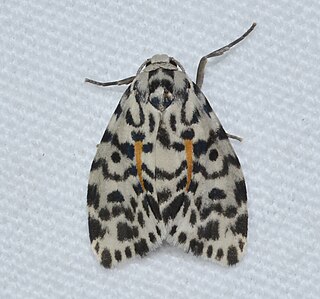
Rosacea is a long-term skin condition that typically affects the face. It results in redness, pimples, swelling, and small and superficial dilated blood vessels. Often, the nose, cheeks, forehead, and chin are most involved. A red, enlarged nose may occur in severe disease, a condition known as rhinophyma.

Perioral dermatitis, also known as periorificial dermatitis, is a common type of skin rash. Symptoms include multiple small (1–2 mm) bumps and blisters sometimes with background redness and scale, localized to the skin around the mouth and nostrils. Less commonly the eyes and genitalia may be involved. It can be persistent or recurring and resembles particularly rosacea and to some extent acne and allergic dermatitis. The term "dermatitis" is a misnomer because this is not an eczematous process.

Brimonidine is a medication used to treat open-angle glaucoma, ocular hypertension, and rosacea. In rosacea it improves the redness. It is used as eye drops or applied to the skin.

Rhinophyma is a condition causing development of a large, bulbous nose associated with granulomatous infiltration, commonly due to untreated rosacea. The condition is most common in older white males.

Clemensia is a genus of moths in the family Erebidae. The genus was described by Packard in 1864.

Steroid-induced rosacea is an iatrogenic condition from the use of either systemic steroid or topical steroids. It is nearly identical to steroid induced acne from the standpoint of etiology.
Gnathophyma involves swelling of the chin. It is a type of lesion associated with rosacea, a common chronic inflammatory skin disorder of the sebaceous glands characterized by redness, swelling, and acne-like pustules.
Clemensia abnormis is a moth of the family Erebidae. It is found in French Guiana.
Clemensia acroperalis is a moth of the family Erebidae first described by E. Dukinfield Jones in 1908. It is found in Brazil.
Clemensia alembis is a moth of the family Erebidae. It is found in Mexico.
Clemensia cincinnata is a moth of the family Erebidae. It is found in Costa Rica.
Clemensia distincta is a moth of the family Erebidae. It is found in Trinidad.
Clemensia domica is a moth of the family Erebidae first described by Herbert Druce. It is found in Ecuador.
Clemensia flava is a moth of the family Erebidae first described by E. Dukinfield Jones in 1914. It is found in Brazil.
Clemensia lacteata is a moth of the family Erebidae. It is found in Peru.
Clemensia leucogramma is a moth of the family Erebidae. It is found in Panama.
Clemensia maculata is a moth of the family Erebidae. It is found in Peru.
Clemensia mesomima is a moth of the family Erebidae. It is found in Colombia.
Clemensia nubila is a moth of the family Erebidae first described by E. Dukinfield Jones in 1914. It is found in Brazil.
Clemensia remida is a moth of the family Erebidae. It is found in Guatemala.





